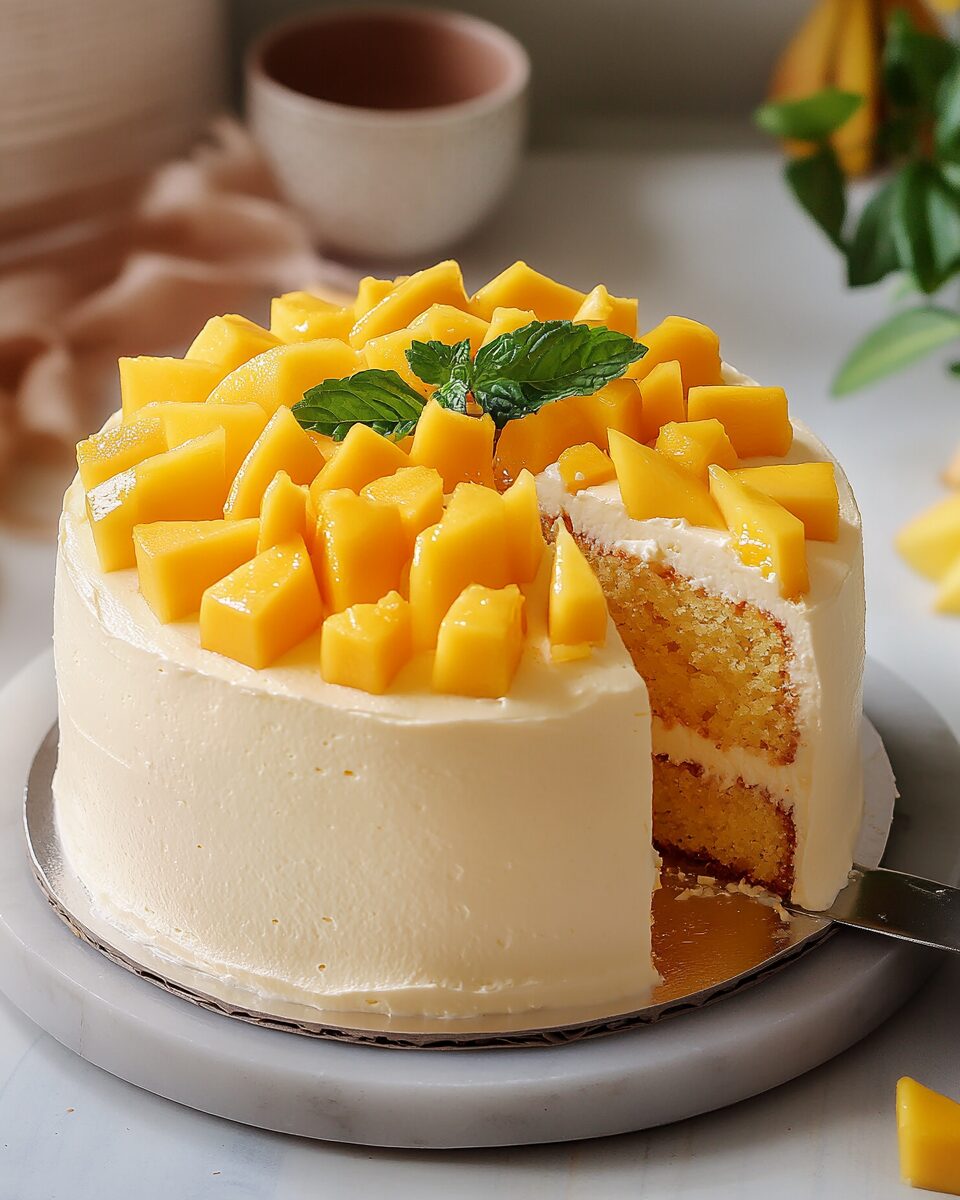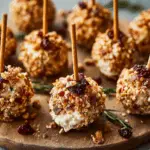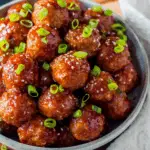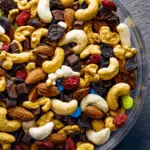This Mango Chiffon Cake is a delicate masterpiece that features light, airy layers of vanilla chiffon cake, enhanced with the vibrant and juicy flavors of fresh mangoes. The whipped cream adds a velvety texture that complements the natural sweetness of the mango, making each bite a tropical delight.
Perfect for summer celebrations or a simple afternoon treat, this cake brings a taste of the tropics to your table. Its soft and fluffy texture, paired with the burst of mango flavor, creates a dessert that is as refreshing as it is beautiful. Whether you’re an experienced baker or a beginner, this recipe is both approachable and impressive.
Full Recipe:
Vanilla Chiffon Cake:
- 1 cup (120 g) cake flour
- 1 teaspoon (4 g) baking powder
- 6 large eggs (whites and yolks separated, room temperature)
- ½ teaspoon (1 g) cream of tartar
- ¾ cup (150 g) sugar, divided
- ¼ teaspoon (1 g) salt
- 2 tablespoons (30 g) milk
- 1 teaspoon (5 g) vanilla extract
- ⅓ cup (70 g) vegetable oil
Whipped Cream:
- 2 ½ cups (600 g) heavy whipping cream
- ¼ cup (40 g) powdered sugar
- 1 teaspoon vanilla extract
Mangoes:
- 2 fresh mangos, peeled and cubed
Directions:
- Prepare the oven and cake pans: Preheat your oven to 350°F (175°C) and line the bottom of three 6-inch cake pans with parchment paper. Do not grease. Set aside.
- Mix dry ingredients: In a large mixing bowl, sift the cake flour and baking powder. Whisk to combine. Set aside.
- Make the meringue: Using a stand mixer or hand mixer, beat the egg whites in a large mixing bowl until foamy. Add the cream of tartar and beat on high until the egg whites turn pale and frothy. Gradually add ⅓ of the sugar (1/4 cup) one tablespoon at a time until stiff peaks form.
- Egg yolk mixture: In another bowl, beat the egg yolks, remaining sugar (1/2 cup), salt, milk, and vanilla. Beat on high speed until fluffy and pale yellow. Fold the dry ingredient mixture into the egg yolk mixture in 3 additions.
- Add oil to the egg yolk mixture: Mix a few spoonfuls of the egg yolk mixture with the oil. Combine this mixture back into the main egg yolk mixture.
- Combine meringue with egg yolk mixture: Fold the egg white meringue into the egg yolk mixture in 3 parts, folding gently each time until no streaks remain.
- Bake: Divide the cake batter into the three 6-inch cake pans. Bake for 20-22 minutes or until a toothpick comes out clean. Let cool completely before assembly.
- Whipped cream: In a bowl, beat the whipping cream, powdered sugar, and vanilla extract on high until medium-stiff peaks form. Chill until assembly.
- Assemble the cake: Layer the cake with whipped cream and mango chunks. Decorate with whipped cream and mango chunks on top.
- Chill: Chill the cake for 1-2 hours before serving.
Prep Time: 20 minutes | Cooking Time: 20 minutes | Chill Time: 2 hours | Total Time: 3 hours 10 minutes
Kcal: 783 kcal | Servings: 6 servings
Background and Inspiration
Mango Chiffon Cake is a popular dessert in Asian bakeries, known for its light and fluffy texture combined with the vibrant and fresh flavors of mango. This cake draws inspiration from the Japanese-style strawberry shortcake, substituting the strawberries with ripe, juicy mangoes. The use of chiffon cake makes it distinctively airy and soft, providing a delicate base that pairs perfectly with the fresh mango filling. This dessert is often enjoyed during the summer months when mangoes are in season, making it a refreshing treat for warm weather.
Ingredients Breakdown
- Vanilla Chiffon Cake: The chiffon cake uses cake flour to achieve a light, airy texture that is less dense than regular sponge cakes. The use of both whipped egg whites and yolks creates a delicate crumb. Cream of tartar helps stabilize the egg whites, while vegetable oil adds moisture to the cake. Vanilla extract and sugar give a gentle sweetness and flavor that allows the mango to shine.
- Whipped Cream: The whipped cream frosting is simple yet luxurious. Heavy whipping cream is lightly sweetened with powdered sugar and flavored with vanilla extract. The whipped cream adds a smooth, velvety texture that balances the cake’s lightness.
- Mango Filling: Fresh mangoes are the star of this recipe. Their natural sweetness and tropical flavor add a refreshing contrast to the cake’s lightness. It’s essential to use ripe mangoes for the best flavor and texture.
Why You’ll Love This Recipe
- Light and Airy Texture: Unlike traditional dense cakes, the chiffon cake base in this recipe is incredibly light and fluffy. It melts in your mouth, making each bite a delightful experience.
- Fresh and Natural Flavors: The use of fresh mangoes adds a tropical sweetness to the cake without being overly sugary. Paired with the lightly sweetened whipped cream, it strikes the perfect balance for those who prefer a less sweet dessert.
- Perfect for Any Occasion: This cake is versatile and can be enjoyed at casual family gatherings, summer picnics, or more formal celebrations like birthdays and anniversaries.
- Customizable: Although this recipe uses mangoes, it can be adapted to include other fruits like strawberries, kiwi, or peaches. You can also experiment with different frostings such as buttercream or cream cheese.
Expert Tips for Perfect Mango Chiffon Cake
- Gradually Add Sugar to Egg Whites: When making the meringue, add the sugar slowly to ensure the egg whites reach stiff peaks without collapsing.
- Don’t Over-Mix: When folding the meringue into the egg yolk mixture, be gentle to avoid deflating the batter. Over-mixing can lead to a denser cake.
- Use Ripe Mangoes: The mangoes should give slightly when pressed, indicating they are ripe. This will ensure a sweet, juicy filling that complements the light cake.
- Chill Before Serving: Since this cake is frosted with whipped cream, it’s important to chill it before slicing to maintain its shape and freshness.
Serving and Storage
This Mango Chiffon Cake is best served chilled, making it an ideal dessert for warm weather. After assembling the cake, let it chill in the refrigerator for at least 1-2 hours. This allows the flavors to meld together and makes slicing easier.
For storage, keep the cake in an airtight container in the refrigerator for up to 3 days. Since the whipped cream frosting is delicate, it’s not suitable for freezing as it may alter the texture upon thawing.
Variations and Substitutions
- Fruit Variations: If mangoes are not in season, you can use other fruits like strawberries, blueberries, or peaches. Alternatively, a combination of tropical fruits like pineapple and kiwi would also work well.
- Frosting Alternatives: If you prefer a richer frosting, you can replace the whipped cream with vanilla buttercream or cream cheese frosting. For a more tropical twist, consider adding a hint of coconut cream to the whipped cream.
- Make it Gluten-Free: Use a gluten-free cake flour blend in place of regular cake flour to make this cake gluten-free without compromising the texture.
The Origin of Chiffon Cake
Chiffon cake is a classic dessert that originated in the United States in the 1920s. It was invented by an insurance salesman named Harry Baker, who later sold the recipe to General Mills in the 1940s. Unlike traditional sponge cakes, chiffon cakes incorporate vegetable oil instead of butter, creating a moist, tender crumb that stays soft even after refrigeration. The oil-based batter is lightened by whipped egg whites, making the cake both airy and delicate. This style of cake quickly became popular in Asian bakeries, where it was often paired with fresh fruits and light, whipped cream to suit the preference for less sweet desserts. The Mango Chiffon Cake is a beautiful fusion of Western baking techniques and Asian flavors, offering a delightful balance of lightness and natural sweetness.
Step-by-Step Tips and Tricks
- Whipping the Egg Whites: Achieving the perfect meringue is key to a successful chiffon cake. Start by whipping the egg whites until foamy, then gradually add the sugar to avoid deflating the air bubbles. Beat until stiff peaks form, where the egg whites hold their shape and the tips slightly droop over without collapsing.
- Folding Technique: When combining the meringue with the egg yolk mixture, use a gentle folding motion to preserve the airiness. Use a spatula to scoop from the bottom of the bowl and fold over the mixture, turning the bowl as you go. This technique ensures that the batter stays light and airy, giving the cake its signature fluffiness.
- Cake Cooling: Unlike traditional cakes, chiffon cakes are best cooled upside down to maintain their volume. If your cake pan has legs, invert the pan and allow it to rest on these legs until the cake cools completely. If your pan does not have legs, you can invert it over the neck of a bottle or a sturdy funnel.
- Choosing the Right Mangoes: The quality of the mangoes can significantly impact the cake’s flavor. Opt for ripe mangoes that are fragrant and give slightly when pressed. The flesh should be vibrant in color, juicy, and sweet. Some excellent mango varieties for this cake include Ataulfo (Honey), Haden, and Kent mangoes.
- Decorating with Piping: For a professional-looking finish, use a piping bag with a star tip to create decorative swirls on top of the cake. This not only adds visual appeal but also provides a delightful contrast in texture with the smooth mango chunks. You can also garnish with a sprinkle of finely chopped mint or edible flowers for an elegant touch.
Pairing Suggestions
- Beverages: Serve this cake with a light beverage such as jasmine tea, green tea, or a fruity iced tea like peach or hibiscus. For an elevated experience, pair it with a sparkling wine or champagne that complements the mango’s tropical notes.
- Dessert Table: If you are serving this cake at a gathering, it pairs beautifully with other light desserts such as fruit tarts, lemon sorbet, or panna cotta. This variety offers guests a refreshing array of sweet options.
Advanced Customization Ideas
- Mango Puree Drizzle: Enhance the mango flavor by making a simple mango puree drizzle. Blend fresh mango chunks with a little sugar and lime juice until smooth. Drizzle this over the cake slices just before serving for an extra burst of mango goodness.
- Tropical Twist: For a more exotic version, add a layer of passion fruit curd between the cake layers. This will introduce a tangy element that contrasts with the sweetness of the mango and the creaminess of the whipped frosting.
- Coconut Infusion: To give the cake a tropical vibe, add a tablespoon of coconut cream to the whipped cream frosting and a sprinkle of toasted coconut flakes on top. This will provide a subtle coconut flavor that enhances the overall tropical profile of the cake.
Storage and Make-Ahead Instructions
- Make-Ahead: The chiffon cake layers can be baked a day in advance. Wrap each layer tightly in plastic wrap and store them at room temperature or refrigerate if it’s a particularly warm day. On the day of serving, prepare the whipped cream and assemble the cake.
- Freezing: While the assembled cake with whipped cream frosting is not suitable for freezing, the chiffon cake layers can be frozen. Wrap the cooled cake layers in plastic wrap and place them in a freezer-safe bag for up to 1 month. Defrost at room temperature for a few hours before frosting.
- Leftovers: Store any leftovers in an airtight container in the refrigerator. The cake will stay fresh for up to 3 days. To maintain its fluffiness, avoid leaving the cake at room temperature for extended periods, especially in warm weather.
Cultural Significance
In many Asian countries, fresh fruit cakes like this Mango Chiffon Cake hold cultural significance, especially during celebrations and festivals. In places like Japan and Korea, fruit-adorned cakes are popular during holidays and birthdays, symbolizing prosperity and joy. The lightness of the chiffon cake, combined with the natural sweetness of fresh fruits, aligns with the preference for less sweet, more refreshing desserts in Asian culinary traditions. Serving this Mango Chiffon Cake at gatherings can be a delightful way to introduce a piece of this cultural appreciation for elegant and fruit-forward desserts.
Serving Suggestions and Presentation
When serving this Mango Chiffon Cake, use a serrated knife for cleaner slices, as the light and airy texture of the chiffon cake can be delicate. Arrange the slices on a serving platter and garnish with extra mango slices or a small dollop of whipped cream. For an added visual appeal, sprinkle some edible gold dust or coconut flakes on top. Serve the cake on dessert plates with a small fork and a napkin to complete the presentation.
Conclusion
This Mango Chiffon Cake is a perfect blend of light, airy texture and tropical sweetness. Its delicate chiffon layers paired with fresh mango and whipped cream make it an ideal dessert for any occasion. Whether you’re looking for a refreshing summer treat or a unique cake to impress your guests, this recipe offers the perfect balance of flavor and elegance. Easy to customize and adaptable to different tastes, it’s a must-try for both novice and experienced bakers.






